Minimally invasive treatments for lower urinary tract symptoms in men with benign prostatic hyperplasia: a network meta-analysis
- PMID: 34693990
- PMCID: PMC8543673
- DOI: 10.1002/14651858.CD013656.pub2
Minimally invasive treatments for lower urinary tract symptoms in men with benign prostatic hyperplasia: a network meta-analysis
Abstract
Background: A variety of minimally invasive treatments are available as an alternative to transurethral resection of the prostate (TURP) for management of lower urinary tract symptoms (LUTS) in men with benign prostatic hyperplasia (BPH). However, it is unclear which treatments provide better results.
Objectives: Our primary objective was to assess the comparative effectiveness of minimally invasive treatments for lower urinary tract symptoms in men with BPH through a network meta-analysis. Our secondary objective was to obtain an estimate of relative ranking of these minimally invasive treatments, according to their effects.
Search methods: We performed a comprehensive search of multiple databases (CENTRAL, MEDLINE, Embase, Scopus, Web of Science and LILACS), trials registries, other sources of grey literature, and conference proceedings, up to 24 February 2021. We had no restrictions on language of publication or publication status.
Selection criteria: We included parallel-group randomized controlled trials assessing the effects of the following minimally invasive treatments, compared to TURP or sham treatment, on men with moderate to severe LUTS due to BPH: convective radiofrequency water vapor therapy (CRFWVT); prostatic arterial embolization (PAE); prostatic urethral lift (PUL); temporary implantable nitinol device (TIND); and transurethral microwave thermotherapy (TUMT).
Data collection and analysis: Two review authors independently screened the literature, extracted data, and assessed risk of bias. We performed statistical analyses using a random-effects model for pair-wise comparisons and a frequentist network meta-analysis for combined estimates. We interpreted them according to Cochrane methods. We planned subgroup analyses by age, prostate volume, and severity of baseline symptoms. We used risk ratios (RRs) with 95% confidence intervals (CIs) to express dichotomous data and mean differences (MDs) with 95% CIs to express continuous data. We used the GRADE approach to rate the certainty of evidence.
Main results: We included 27 trials involving 3017 men, mostly over age 50, with severe LUTS due to BPH. The overall certainty of evidence was low to very low due to concerns regarding bias, imprecision, inconsistency (heterogeneity), and incoherence. Based on the network meta-analysis, results for our main outcomes were as follows. Urologic symptoms (19 studies, 1847 participants): PUL and PAE may result in little to no difference in urologic symptoms scores (MD of International Prostate Symptoms Score [IPSS]) compared to TURP (3 to 12 months; MD range 0 to 35; higher scores indicate worse symptoms; PUL: 1.47, 95% CI -4.00 to 6.93; PAE: 1.55, 95% CI -1.23 to 4.33; low-certainty evidence). CRFWVT, TUMT, and TIND may result in worse urologic symptoms scores compared to TURP at short-term follow-up, but the CIs include little to no difference (CRFWVT: 3.6, 95% CI -4.25 to 11.46; TUMT: 3.98, 95% CI 0.85 to 7.10; TIND: 7.5, 95% CI -0.68 to 15.69; low-certainty evidence). Quality of life (QoL) (13 studies, 1459 participants): All interventions may result in little to no difference in the QoL scores, compared to TURP (3 to 12 months; MD of IPSS-QoL score; MD range 0 to 6; higher scores indicate worse symptoms; PUL: 0.06, 95% CI -1.17 to 1.30; PAE: 0.09, 95% CI -0.57 to 0.75; CRFWVT: 0.37, 95% CI -1.45 to 2.20; TUMT: 0.65, 95% CI -0.48 to 1.78; TIND: 0.87, 95% CI -1.04 to 2.79; low-certainty evidence). Major adverse events (15 studies, 1573 participants): TUMT probably results in a large reduction of major adverse events compared to TURP (RR 0.20, 95% CI 0.09 to 0.43; moderate-certainty evidence). PUL, CRFWVT, TIND and PAE may also result in a large reduction in major adverse events, but CIs include substantial benefits and harms at three months to 36 months; PUL: RR 0.30, 95% CI 0.04 to 2.22; CRFWVT: RR 0.37, 95% CI 0.01 to 18.62; TIND: RR 0.52, 95% CI 0.01 to 24.46; PAE: RR 0.65, 95% CI 0.25 to 1.68; low-certainty evidence). Retreatment (10 studies, 799 participants): We are uncertain about the effects of PAE and PUL on retreatment compared to TURP (12 to 60 months; PUL: RR 2.39, 95% CI 0.51 to 11.1; PAE: RR 4.39, 95% CI 1.25 to 15.44; very low-certainty evidence). TUMT may result in higher retreatment rates (RR 9.71, 95% CI 2.35 to 40.13; low-certainty evidence). Erectile function (six studies, 640 participants): We are very uncertain of the effects of minimally invasive treatments on erectile function (MD of International Index of Erectile Function [IIEF-5]; range 5 to 25; higher scores indicates better function; CRFWVT: 6.49, 95% CI -8.13 to 21.12; TIND: 5.19, 95% CI -9.36 to 19.74; PUL: 3.00, 95% CI -5.45 to 11.44; PAE: -0.03, 95% CI -6.38, 6.32; very low-certainty evidence). Ejaculatory dysfunction (eight studies, 461 participants): We are uncertain of the effects of PUL, PAE and TUMT on ejaculatory dysfunction compared to TURP (3 to 12 months; PUL: RR 0.05, 95 % CI 0.00 to 1.06; PAE: RR 0.35, 95% CI 0.13 to 0.92; TUMT: RR 0.34, 95% CI 0.17 to 0.68; low-certainty evidence). TURP is the reference treatment with the highest likelihood of being the most efficacious for urinary symptoms, QoL and retreatment, but the least favorable in terms of major adverse events, erectile function and ejaculatory function. Among minimally invasive procedures, PUL and PAE have the highest likelihood of being the most efficacious for urinary symptoms and QoL, TUMT for major adverse events, PUL for retreatment, CRFWVT and TIND for erectile function and PUL for ejaculatory function.
Authors' conclusions: Minimally invasive treatments may result in similar or worse effects concerning urinary symptoms and QoL compared to TURP at short-term follow-up. They may result in fewer major adverse events, especially in the case of PUL and PAE; resulting in better rankings for symptoms scores. PUL may result in fewer retreatments compared to other interventions, especially TUMT, which had the highest retreatment rates at long-term follow-up. We are very uncertain about the effects of these interventions on erectile function. There was limited long-term data, especially for CRFWVT and TIND. Future high-quality studies with more extended follow-up, comparing different, active treatment modalities, and adequately reporting critical outcomes relevant to patients, including those related to sexual function, could provide more information on the relative effectiveness of these interventions.
Copyright © 2021 The Cochrane Collaboration. Published by John Wiley & Sons, Ltd.
Conflict of interest statement
JVAF: none known.
JHJ: none known.
MI: none known.
SY: Boston Scientific (speaker), Galvanize (consultant)
JG: none known.
MB: Boston Scientific (consultant for endourology and stone management), Auris Health (consultant for robotic surgery and endourology).
MIO: none known.
CMEL: none known.
AAV: none known.
LG: none known.
PD: none known.
Figures







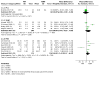
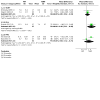
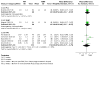
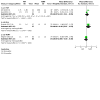
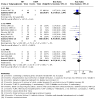
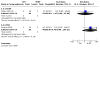
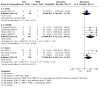
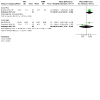

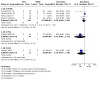


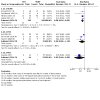
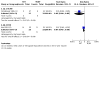
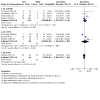
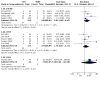

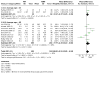
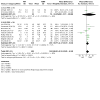


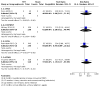
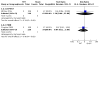
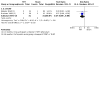
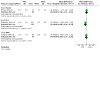


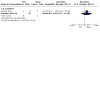
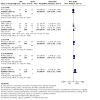
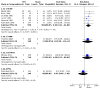

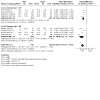
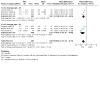
Update of
- doi: 10.1002/14651858.CD013656
References
References to studies included in this review
Abbou 1995 {published data only}
-
- Abbou CC, Payan C, Viens-Bitker C, Richard F, Boccon-Gibod L, Jardin A, et al. Transrectal and transurethral hyperthermia versus sham treatment in benign prostatic hyperplasia: a double-blind randomized multicentre clinical trial. British Journal of Urology 1995;76:619-24. - PubMed
Abt 2018 {published data only}
-
- Abt D, Hechelhammer L, Müllhaupt G, Kessler T, Schmid H P, Engeler DS, et al. Prostatic artery embolization vs conventional TUR-P in the treatment of benign prostatic hyperplasia: First results of a prospective, randomized non-inferiority trial. European Urology, Supplements 2016;15(3):e1080. [DOI: 10.1016/S1569-9056(16)61081-3] - DOI
-
- Abt D, Hechelhammer L, Müllhaupt G, Markart S, Güsewell S, Kessler TM, et al. Comparison of prostatic artery embolisation (PAE) versus transurethral resection of the prostate (TURP) for benign prostatic hyperplasia: randomised, open label, non-inferiority trial. BMJ 2018;361:k2338. [DOI: 10.1136/bmj.k2338] - DOI - PMC - PubMed
-
- Abt D, Müllhaupt G, Hechelhammer L, Markart S, Güsewell S, Schmid HP, et al. Prostatic artery mmbolisation versus transurethral resection of the prostate for penign prostatic hyperplasia: 2-yr outcomes of a randomised, open-label, single-centre trial. European Urology 18 February 2021 [Online ahead of print]. [DOI: 10.1016/j.eururo.2021.02.008] - DOI - PubMed
-
- Abt D, Mordasini L, Hechelhammer L, Kessler TM, Schmid HP, Engeler DS. Prostatic artery embolization versus conventional TUR-P in the treatment of benign prostatic hyperplasia: protocol for a prospective randomized non-inferiority trial. BMC Urology 2014;14:94. [DOI: 10.1186/1471-2490-14-94] - DOI - PMC - PubMed
-
- NCT02054013. Prostatic artery embolization vs. conventional transurethral prostatectomy in the treatment of benign prostatic hyperplasia. Available from clinicaltrials.gov/ct2/show/NCT02054013 (accessed 15 March 2020).
Ahmed 1997 {published data only}
-
- Ahmed M, Bell T, Lawrence WT, Ward JP, Watson GM. Transurethral microwave thermotherapy (Prostatron version 2.5) compared with transurethral resection of the prostate for the treatment of benign prostatic hyperplasia: a randomized, controlled, parallel study. British Journal of Urology 1997;79:181-5. - PubMed
Albala 2002 {published data only}
-
- Albala DM, Fulmer BR, Turk TMT, Koleski F, Andriole G, Davis BE, et al. Office-based transurethral microwave thermotherapy using the TherMatrx TMx-2000. Journal of Endourology 2002;16:57-61. - PubMed
Bdesha 1994 {published data only}
-
- Bdesha AS, Bunce CJ, Snell ME, Witherow RO. A sham controlled trial of transurethral microwave therapy with subsequent treatment of the control group. Journal of Urology 1994;152:453-8. - PubMed
Blute 1996 {published data only}
-
- Blute ML, Patterson DE, Segura JW, Tomera KM, Hellerstein DK. Transurethral microwave thermotherapy v sham treatment: double-blind randomized study. Journal of Endourology 1996;10:565-73. - PubMed
Brehmer 1999 {published data only}
-
- Brehmer M, Wiksell H, Kinn A. Sham treatment compared with 30 or 60 min of thermotherapy for benign prostatic hyperplasia: a randomized study. BJU International 1999;84:292-6. - PubMed
Carnevale 2016 {published data only}
-
- Carnevale FC, Iscaife A, Yoshinaga EM, Moreira AM, Antunes AA, Srougi M. Transurethral resection of the prostate (TURP) versus original and perfected prostate artery embolization (PAE) due to benign prostatic hyperplasia (BPH): preliminary results of a single center, prospective, urodynamic-controlled analysis. Cardiovascular and interventional radiology 2016;39(1):44-52. [DOI: 10.1007/s00270-015-1202-4] - DOI - PubMed
-
- Yoshinaga EM, Nakano E, Marchini GS, Galvao O, Baroni R, Carnevale FC, et al. A prospective and randomized trial comparing transurethral resection of the prostate (TURP) to prostate artery embolization (PAE) for treatment of bladder outlet obstruction due to benign prostatic hyperplasia (BPH). Journal of Urology 2014;191(4 Suppl):e793. [DOI: 10.1016/j.juro.2014.02.2168] - DOI
Chughtai 2020 {published data only}
-
- Chughtai B, Elterman D, Shore N, Gittleman M, Motola J, Pike S et al. The iTind Temporarily Implanted Nitinol Device for the Treatment of Lower Urinary Tract Symptoms Secondary to Benign Prostatic Hyperplasia: A Multicenter, Randomized, Controlled Trial. Urology 2020;Online ahead of print:1-7. [DOI: 10.1016/j.urology.2020.12.022] - DOI - PubMed
-
- NCT02506465. Pivotal study to assess the safety and effectiveness of the iTIND device. Available from clinicaltrials.gov/ct2/show/NCT02506465 (First posted: 23 July 2015).
D'Ancona 1998 {published data only}
-
- D'Ancona FC, Francisca EA, Witjes WP, Welling L, Debruyne FM, la Rosette JJ. High energy thermotherapy versus transurethral resection in the treatment of benign prostatic hyperplasia: results of a prospective randomized study with 1 year of followup. Journal of Urology 1997;158:120-5. - PubMed
-
- D'Ancona FC, Francisca EA, Witjes WP, Welling L, Debruyne FM, De La Rosette JJ. Transurethral resection of the prostate vs high-energy thermotherapy of the prostate in patients with benign prostatic hyperplasia: long-term results. British Journal of Urology 1998;81:259-64. - PubMed
Dahlstrand 1995 {published data only}
-
- Dahlstrand C, Geirsson G, Fall M, Pettersson S. Transurethral microwave thermotherapy versus transurethral resection for benign prostatic hyperplasia: preliminary results of a randomized study. European Urology 1993;23:292-8. - PubMed
-
- Dahlstrand C, Walden M, Geirsson G, Pettersson S. Transurethral microwave thermotherapy versus transurethral resection for symptomatic benign prostatic obstruction: a prospective randomized study with a 2-year follow-up. British Journal of Urology 1995;76:614-8. - PubMed
-
- Dahlstrand C, Walden M, Geirsson G, Sommar S, Pettersson S. Transurethral microwave thermotherapy versus transurethral resection for BPH. Transurethral microwave thermotherapy versus transurethral resection for BPH. Progress in Clinical and Biological Research 1994;386:455-61. - PubMed
De Wildt 1996 {published data only}
-
- De La Rosette JJMCH, De Wilt MJAM, Alivizatos G, Froeling FMJA, Debruyne FMJ. Transurethral microwave thermotherapy (TUMT) in benign prostatic hyperplasia: placebo versus TUMT. Urology 1994;44:58-63. - PubMed
-
- De Wildt MJ, Hubregtse M, Ogden C, Carter SS, Debruyne FM, De la Rosette JJ. A 12-month study of the placebo effect in transurethral microwave thermotherapy. British Journal of Urology 1996;77:221-7. - PubMed
-
- Francisca EA, d Ancona FC, Hendriks JC, Kiemeney LA, Debruyne FM, la Rosette JJ. Quality of life assessment in patients treated with lower energy thermotherapy (Prostasoft 2.0): results of a randomized transurethral microwave thermotherapy versus sham study. Journal of Urology 1997;158:1839-44. - PubMed
-
- Ogden CW, Reddy P, Johnson H, Ramsay JW, Carter SS. Sham versus transurethral microwave thermotherapy in patients with symptoms of benign prostatic bladder outflow obstruction. Lancet 1993;341:14-7. - PubMed
Floratos 2001 {published data only}
-
- Floratos DL, Kiemeney LA, Rossi C, Kortmann BB, Debruyne FM, La Rosette JJ. Long-term followup of randomized transurethral microwave thermotherapy versus transurethral prostatic resection study. Journal of Urology 2001;165:1533-8. - PubMed
-
- Francisca EA, d Ancona FC, Hendriks JC, Kiemeney LA, Debruyne FM, La Rosette JJ. A randomized study comparing high-energy TUMT to TURP: quality-of-life results. European Urology 2000;38:569-75. - PubMed
Gao 2014 {published data only}
-
- Gao Ya, Huang Y, Zhang R, Yang Yd, Zhang Q, Hou M, et al. Benign prostatic hyperplasia: prostatic arterial embolization versus transurethral resection of the prostate--a prospective, randomized, and controlled clinical trial. Radiology 2014;270(3):920-8. [DOI: 10.1148/radiol.13122803] - DOI - PubMed
Gratzke 2017 {published data only}
-
- Barber N, Sønsken J, Gratze C, Speakman M, Berges R, Wetterauer U, et al. BPH6 randomized study of prostatic urethral lift (PUL) vs transurethral resection of the prostate (TURP): outcomes and patient satisfaction. Journal of Urology 2015;193(Suppl 4):e19. [DOI: 10.1016/j.juro.2015.02.104] - DOI
-
- Chin P, Sønsken J, Barber N, Gratzke C, Speakman M, Berges R, et al. BPH6 trial: a multi-centre, prospective, randomised study of the prostatic urethral lift vs. transurethral resection of the prostate (TURP). BJU International 2015;115(Suppl 4):10. [DOI: 10.1111/bju.13072] - DOI
-
- Gratzke C, Barber NJ, Speakman MJ, Berges R, Wetterauer U, Greene D, et al. Two year results of the BPH6 trial: a multi-center, prospective, randomized study of the prostatic urethral lift (PUL) vs transurethral resection of the prostate (TURP). European Urology Supplements 2016;15(3):e1076-a. [DOI: 10.1016/S1569-9056(16)61077-1] - DOI
Insausti 2020 {published data only}
-
- Giral Villalta PJ, Aguilar Guevara JF, Lopez Ubillos G, Lacarra Fernandez S, Zabalo San Juan A, Asiáin Urmeneta M, et al. Prostatic artery embolization versus transurethral resection of the prostate in the treatment of benign prostatic hyperplasia: 12 month results of a clinical trial. European Urology, Supplements 2019;18(1):e1494-5. [DOI: 10.1016/S1569-9056(19)31075-9] - DOI
-
- Insausti I, Sáez de Ocáriz García A, Galbete A, Capdevila F, Solchaga S, Giral P, et al. Randomized comparison of prostatic arterial embolization versus transurethral resection of the prostate for treatment of benign prostatic hyperplasia. Journal of Vascular and Interventional Radiology 2020 Apr 2 [Epub ahead of print]. [DOI: 10.1016/j.jvir.2019.12.810] - DOI - PubMed
-
- Napal Lecumberri S, Insausti Gorbea I, Sáez de Ocáriz García A, Solchaga Álvarez S, Cebrián Lostal JL, Monreal Beortegui R, et al. Prostatic artery embolization versus transurethral resection of the prostate in the treatment of benign prostatic hyperplasia: protocol for a non-inferiority clinical trial. Research and Reports in Urology 2018;10:17-22. [DOI: 10.2147/RRU.S139086] - DOI - PMC - PubMed
-
- NCT01963312. Clinical trial to evaluate the efficacy and safety of the transarterial supraselective embolization of the prostate to treat the urinary symptoms. Available from clinicaltrials.gov/ct2/show/NCT01963312 (accessed 15 March 2020).
-
- Saez De Ocariz Garcia A, Insausti Gorbea I, Solchaga Alvarez S, Monreal Beortegui R, Giral Villalta PJ, Napal Lecumberri S, et al. Prostatic artery embolization versus transurethral resection of the prostate in the treatment of benign prostatic hyperplasia: 6-month results of a clinical trial. Cardiovascular and Interventional Radiology 2017;40(2):S117-8.
Larson 1998 {published data only}
-
- Larson TR, Blute ML, Bruskewitz RC, Mayer RD, Ugarte RR, Utz WJ. A high-efficiency microwave thermoablation system for the treatment of benign prostatic hyperplasia: results of a randomized, sham-controlled, prospective, double-blind, multicenter clinical trial. Urology 1998;51:731-42. - PubMed
McVary 2016 {published data only}
-
- Albala DM, McVary K, Roehrborn C. Convective water vapor thermal therapy: 3-year durable outcomes of a randomized controlled study for treatment of lower urinary tract symptoms due to benign prostatic hyperplasia. Canadian Urological Association Journal 2018;12(9):S197. [DOI: 10.5489/cuaj.5656] - DOI
-
- Albala DM, McVary KT, Roehrborn CG, Ulchaker JC. Transurethral convective radiofrequency water vapor thermal therapy for symptomatic benign prostatic hyperplasia: two year outcomes of a randomized, controlled, and prospective crossover study. Canadian Urological Association Journal 2017;11(9):S326-7. [DOI: 10.5489/cuaj.4896] - DOI
-
- Gupta N, Köhler T, McVary K. Convective radiofrequency water vapor energy ablation (Rezūm®) effectively treats lower urinary tract symptoms due to benign prostatic enlargement regardless of obesity while preserving erectile and ejaculatory function. Journal of Urology 2017;197(4):e609.
-
- Gupta N, Köhler T, McVary K. Convective radiofrequency water vapor energy ablation effectively treats lower urinary tract symptoms due to benign prostatic enlargement regardless of obesity while preserving erectile and ejaculatory function: results of a multicenter, randomized, controlled trial. European Urology 2017;16(3 (Supplement)):e521-2. [DOI: 10.1016/S1569-9056(17)30366-4] - DOI
-
- Gupta N, Köhler TS, McVary KT. Convective water vapor energy ablation effectively treats lower urinary tract symptoms due to benign prostatic enlargement while preserving erectile and ejaculatory function: results of a multicenter, randomized, controlled trial. Journal of Sexual Medicine 2017;14(2):e33.
Nawrocki 1997 {published data only}
-
- Nawrocki JD, Bell TJ, Lawrence WT, Ward JP. A randomized controlled trial of transurethral microwave thermotherapy. British Journal of Urology 1997;79:389-93. - PubMed
Norby 2002 {published data only}
-
- Norby B, Nielsen HV, Frimodt-Moller PC. Transurethral interstitial laser coagulation of the prostate and transurethral microwave thermotherapy vs transurethral resection or incision of the prostate: results of a randomized, controlled study in patients with symptomatic benign prostatic hyperplasia. BJU International 2002;90:853-62. - PubMed
Pisco 2020 {published data only}
-
- NCT02074644. Clinical trial of prostatic arterial embolization versus a sham procedure to treat benign prostatic hyperplasia. Available from clinicaltrials.gov/ct2/show/NCT02074644 (accessed 13 March 2020).
Radwan 2020 {published data only}
-
- Radwan A, Farouk A, Higazy A, Samir YR, Tawfeek AM, Gamal MA. Prostatic artery embolization versus transurethral resection of the prostate in management of benign prostatic hyperplasia. Prostate International 2020 April 23 [Epub ahead of print]. [DOI: 10.1016/j.prnil.2020.04.001] - DOI - PMC - PubMed
Roehrborn 1998 {published data only}
-
- Roehrborn CG, Preminger G, Newhall P, Denstedt J, Razvi H, Chin LJ, et al. Microwave thermotherapy for benign prostatic hyperplasia with the Dornier Urowave: results of a randomized, double-blind, multicenter, sham-controlled trial. Urology 1998;51:19-28. - PubMed
-
- Trachtenberg J, Roehborn CG. Updated results of a randomized, double-blind, multicenter sham-controlled trial of microwave thermotherapy with the Dornier Urowave in patients with symptomatic benign prostatic hyperplasia. World Journal of Urology 1998;16:102-8. - PubMed
Roehrborn 2013 {published data only}
-
- Barkin J. Prospective, randomized, controlled study of five-year results on prostatic urethral lift (PUL). Canadian Urological Association Journal 2017;11(9):S326. [DOI: 10.5489/cuaj.4896] - DOI
-
- NCT01294150. The safety and effectiveness of UroLift: LIFT Pivotal Study (LIFT). Available from clinicaltrials.gov/ct2/show/NCT01294150 (first received 11 February 2011).
-
- Rane A, McNicholas T, Woo H, Roehrborn C. 4 year results of the randomized, controlled, blinded, multi-center study for the prostatic urethral lift: the L.I.F.T. study. Journal of Endourology 2017;30(Suppl 2):A105-6.
-
- Rashid P, Chin P, Bolton D, Roehrborn C, McVary K. Prospective, randomised study of prostatic urethral lift: five year results. BJU International 2017;119(Suppl 2):45. [DOI: 10.1111/jsm.12333] - DOI
Venn 1995 {published data only}
-
- Venn SN, Montgomery BS, Sheppard SA, Hughes SW, Beard RC, Bultitiude MI, et al. Microwave hyperthermia in benign prostatic hypertrophy: a controlled clinical trial. British Journal of Urology 1995;76:73-6. - PubMed
Wagrell 2002 {published data only}
-
- Mattiasson A, Wagrell L, Schelin S, Nordling J, Richthoff J, Magnusson B, et al. Five-year follow-up of feedback microwave thermotherapy versus TURP for clinical BPH: a prospective randomized multicenter study. Urology 2007;69:91-7. - PubMed
-
- Wagrell L, Schelin S, Nordling J, Richthoff J, Magnusson B, Schain M, et al. Three-year follow-up of feedback microwave thermotherapy versus TURP for clinical BPH: a prospective randomized multicenter study. Urology 2004;64:698-702. - PubMed
-
- Wagrell L, Schelin S, Nordling J, Richthoff J, Mangnusson B, Schain M, et al. Feedback microwave thermotherapy versus TURP for clinical BPH − a randomized controlled multicenter study. Urology 2002;60:292-9. - PubMed
Zhu 2018 {published data only}
-
- Zhu C, Lin W, Huang Z, CAI J. Prostate artery embolization and transurethral resection of prostate for benign prostatic hyperplasia: a prospective randomized controlled trial. Chinese Journal of Interventional Imaging and Therapy 2018;15(3):134-8. [DOI: 10.13929/j.1672-8475.201711043] - DOI
References to studies excluded from this review
Albala 2000 {published data only}
-
- Albala DM, Turk TM, Fulmer BR, Koleski F, Andriole G, Davis BE, et al. Periurethral transurethral microwave thermotherapy for the treatment of benign prostatic hyperplasia: an interim 1-year safety and efficacy analysis using the thermatrx TMx-2000. Techniques in Urology 2000;6(4):288-93. - PubMed
Arai 2000 {published data only}
-
- Arai Y, Aoki Y, Okubo K, Maeda H, Terada N, Matsuta Y, et al. Impact of interventional therapy for benign prostatic hyperplasia on quality of life and sexual function: A prospective study. Journal of Urology 2000;164(4):1206-11. - PubMed
Bagla 2017 {published data only}
-
- Bagla S, Smirniotopoulos J, Orlando J, Piechowiak R. Cost analysis of prostate artery embolization (PAE) and transurethral resection of the prostate (TURP) in the treatment of benign prostatic hyperplasia. Cardiovascular and Interventional Radiology 2017;40(11):1694-7. [DOI: 10.1007/s00270-017-1700-7] - DOI - PubMed
-
- Bagla S, Vadlamudi V, Orlando J, Smirniotopoulos J. Cost analysis of prostate artery embolization (PAE) and transurethral resection of the prostate (TURP) in the treatment of benign prostatic hyperplasia. Journal of Vascular and Interventional Radiology 2016;27(3):S56. [DOI: 10.1016/j.jvir.2015.12.154] - DOI - PubMed
Bilhim 2015 {published data only}
-
- Bilhim T, Bagla S, Sapoval M, Carnevale FC, Salem R, Golzarian J. Prostatic arterial embolization versus transurethral resection of the prostate for benign prostatic hyperplasia. Radiology 2015;276(1):310-1. - PubMed
Brown 2018 {published data only}
D'Ancona 1997 {published data only}
-
- D'Ancona FC, Francisca EA, Debruyne FM, De la Rosette JJ. High-energy transurethral microwave thermotherapy in men with lower urinary tract symptoms. Journal of Endourology 1997;11(4):285-9. - PubMed
Dahlstrand 2003 {published data only}
-
- Dahlstrand C. High-energy microwave therapy with benign prostatic hyperplasia. A good and safe therapeutic choice--for both the patient and the health care. Läkartidningen 2003;100(35):2678-83. - PubMed
Djavan 1999 {published data only}
-
- Djavan B, Seitz C, Roehrborn CG, Remzi M, Fakhari M, Waldert M, et al. Targeted transurethral microwave thermotherapy versus alpha-blockade in benign prostatic hyperplasia: outcomes at 18 months. Urology 2001;57(1):66-70. - PubMed
-
- Djavan B, Shariat S, Fakhari M, Ghawidel K, Seitz C, Partin AW, et al. Neoadjuvant and adjuvant alpha-blockade improves early results of high-energy transurethral microwave thermotherapy for lower urinary tract symptoms of benign prostatic hyperplasia: a randomized, prospective clinical trial. Urology 1999;53(2):251-9. - PubMed
Gratzke 2018 {published data only}
-
- Gratzke C, Barkin J, Roehrborn C. Predictors of response to the prostatic urethral lift ( (PUL) treatment. European Urology Supplements 2018;17(2):e1041. [DOI: 10.1016/S1569-9056(18)31556-2] - DOI
Hahn 2000 {published data only}
-
- Hahn RG, Farahmand BY, Hallin A, Hannar N, Persson P-G. Incidence of acute myocardial infarction and cause-specific mortality after transurethral treatments of prostatic hypertrophy. Urology 2000;55(2):236-40. - PubMed
Hansen 1998 {published data only}
-
- Hansen BJ, Mortensen S, Mensink HJ, Flyger H, Riehmann M, Hendolin N, et al. Comparison of the Danish Prostatic Symptom Score with the international Prostatic Symptom Score, the Madsen-Iversen and Boyarsky symptom indexes. British Journal of Urology 1998;81(1):36-41. - PubMed
ISRCTN23921450 {published data only}
-
- ISRCTN23921450. A randomised controlled trial comparing the efficacy, safety and cost-effectiveness of transurethral resection (TURP), laser vaporisation (LVAP), transurethral needle ablation (TUNA) and microwave thermoablation (MTA) of the prostate. www.isrctn.com/ISRCTN23921450 (first received 25 April 2003).
Kobelt 2004 {published data only}
-
- Kobelt G, Spangberg A, Mattiasson A. The cost of feedback microwave thermotherapy compared with transurethral resection of the prostate for treating benign prostatic hyperplasia. BJU International 2004;93(4):543-8. - PubMed
Lim 2011 {published data only}
-
- Kim CS, Song HY, Jeong IG, Yeo HJ, Kim EY, Park JH, et al. Temporary placement of covered retrievable expandable nitinol stents with barbs in high-risk surgical patients with benign prostatic hyperplasia: work in progress. Journal of Vascular Interventional Radiology 2011;22(10):1420-6. - PubMed
Mulvin 1994 {published data only}
-
- Mulvin D, Creagh T, Kelly D, Smith J, Quinlan D, Fitzpatrick J. Transurethral microwave thermotherapy versus transurethral catheter therapy for benign prostatic hyperplasia. European Urology 1994;26(1):6-9. - PubMed
NCT01835860 {unpublished data only}
-
- NCT01835860. Prostatic artery embolization for benign prostatic hyperplasia. Available from clinicaltrials.gov/ct2/show/NCT01835860 (accessed 15 March 2020).
Norby 2002b {published data only}
-
- Nørby B, Nielsen HV, Frimodt-Møller PC. Cost-effectiveness of new treatments for benign prostatic hyperplasia: results of a randomized trial comparing the short-term cost-effectiveness of transurethral interstitial laser coagulation of the prostate, transurethral microwave thermotherapy and standard transurethral resection or incision of the prostate. Scandinavian Journal of Urology and Nephrology 2002;36(4):286-95. - PubMed
Nørby 2004 {published data only}
-
- Nørby B. Minimally invasive treatment of benign prostatic hyperplasia. Ugeskrift for laeger 2004;166(8):688-90. - PubMed
Ohigashi 2007 {published data only}
-
- Ohigashi T, Nakamura K, Nakashima J, Baba S, Murai M. Long-term results of three different minimally invasive therapies for lower urinary tract symptoms due to benign prostatic hyperplasia: Comparison at a single institute. International Journal of Urology 2007;14(4):326-30. - PubMed
Pereira 2018 {published data only}
-
- NCT03043222. Innovative minimally invasive options in treatment of urinary problems related to prostate enlargement (BPH) in men. Available from clinicaltrials.gov/show/NCT03043222 (accessed 6 November 2018).
-
- Pereira K, Ford-Glanton S, Johar R, Xu P, Pham K, Gadani S, et al. Prostatic artery embolization (PAE) and prostatic urethral lift (PUL) procedures for symptomatic benign prostatic enlargement (BPH): a retrospective, single-center comparison of outcomes. Journal of Vascular and Interventional Radiology 2018;29(4 Suppl 1):S6. [DOI: 10.1016/j.jvir.2018.01.010] - DOI
Porpiglia 2015 {published data only}
-
- Fiori C, Amparore D, Checcucci E, Ottaviano G, De Cillis S, Di Stasio A, et al. Medi-Tate temporary implantable nitinol device (TIND) in the treatment of benign prostatic obstruction: two tears of follow-up results. Journal of Urology 2016;195(4, S):E459.
-
- Porpiglia F, Fiori C, Bertolo R, Garrou D, Cattaneo G, Amparore D. Temporary implantable nitinol device (TIND): A novel, minimally invasive treatment for relief of lower urinary tract symptoms (LUTS) related to benign prostatic hyperplasia (BPH): Feasibility, safety and functional results at 1 year of follow-up. BJU International 2015;116(2):278-87. - PubMed
Porpiglia 2019 {published data only}
-
- Porpiglia F, Fiori C, Amparore D, Kadner G, Manit A, Valerio M, et al. Second-generation of temporary implantable nitinol device for the relief of lower urinary tract symptoms due to benign prostatic hyperplasia: results of a prospective, multicentre study at 1 year of follow-up. BJU International 2019;123(6):1061-9. - PubMed
-
- Porpiglia F, Fiori C, Amparore D, Volpi G, Kadner G, Manit A, et al. MP01-05: The results of one-arm multicenter prospective study on an innovative minimally invasive surgical technique for LUTS management. The Journal of Urology 2019;201:e2.
Qiu 2017 {published data only}
-
- Qiu ZL, Zhang CC, Wang XS, Cheng K, Liang X, Wang DW, et al. Clinical evaluation of embolization of the superior vesical prostatic artery for treatment of benign prostatic hyperplasia: a single-center retrospective study. Wideochir Inne Tech Maloinwazyjne 2017;12(4):409-16. [DOI: 10.5114/wiitm.2017.72324] - DOI - PMC - PubMed
Russo 2015 {published data only}
-
- Russo GI, Kurbatov D, Sansalone S, Lepetukhin A, Dubsky S, Sitkin I, et al. Prostatic arterial embolization vs open prostatectomy: a 1-year matched-pair analysis of functional outcomes and morbidities. Urology 2015;86(2):343-8. - PubMed
-
- Russo GI, Kurbatov D, Sansalone S, Lepetukhin A, Dubsky S, Sitkin I, et al. Prostatic arterial embolization vs open prostatectomy: a matched-pair analysis of functional outcomes and morbidities after 1 year of follow-up. European Urology Supplement 2015;14(2):e570. - PubMed
Schelin 2006 {published data only}
-
- Schelin S, Geertsen U, Walter S, Spångberg A, Duelund-Jacobsen J, Krøyer K, et al. Feedback microwave thermotherapy versus TURP/prostate enucleation surgery in patients with benign prostatic hyperplasia and persistent urinary retention: a prospective, randomized, controlled, multicenter study. Urology 2006;68(4):795-9. - PubMed
Servadio 1987 {published data only}
-
- Servadio C, Leib Z, Lev A. Diseases of prostate treated by local microwave hyperthermia. Urology 1987;30(2):97-9. - PubMed
Shore 2010 {published data only}
-
- Shore ND, Sethi PS. A controlled, randomized, head-to-head comparison of the Prolieve Thermodilation System versus the Targis System for benign prostatic hyperplasia: safety, procedural tolerability, and clinical results. Journal of Endourology 2010;24(9):2469-75. - PubMed
Tan 2005 {published data only}
-
- Tan AH, Nott L, Hardie WR, Chin JL, Denstedt JD, Razvi H. Long-term results of microwave thermotherapy for symptomatic benign prostatic hyperplasia. Journal of Endourology 2005;19(10):1191-5. - PubMed
Trock 2004 {published data only}
-
- Trock BJ, Brotzman M, Utz WJ, Ugarte RR, Kaplan SA, Larson TR, et al. Long-term pooled analysis of multicenter studies of cooled thermotherapy for benign prostatic hyperplasia: results at three months through four years. Urology 2004;63(4):716-21. - PubMed
Vesely 2006 {published data only}
-
- Vesely S, Knutson T, Damber J-E, Dicuio M, Dahlstrand C. TURP and low-energy TUMT treatment in men with LUTS suggestive of bladder outlet obstruction selected by means of pressure-flow studies: 8-Year follow-up. Neurourology and Urodynamics 2006;25(7):770-5. - PubMed
Waldén 1998 {published data only}
-
- Waldén M, Acosta S, Carlsson P, Pettersson S, Dahlstrand C. A cost-effectiveness analysis of transurethral resection of the prostate and transurethral microwave thermotherapy for treatment of benign prostatic hyperplasia: two-year follow-up. Scandinavian Journal of Urology and Nephrology 1998;32(3):204-10. - PubMed
Woo 2018 {published data only}
-
- Woo H. Convective radiofrequency water vapor thermal therapy. In: International Journal of Urology. Vol. 25. 2018:139.
Yachia 1996 {published data only}
-
- Yachia D, Aridogan A. Comparison between first-generation (fixed-caliber) and second-generation (self-expanding, large caliber) temporary prostatic stents. Urol Int 1996;57(3):165-9. - PubMed
Zerbib 1992 {published data only}
-
- Zerbib M, Steg A, Conquy S, Martinache PR, Flam TA, Debre B. Localized hyperthermia versus the sham procedure in obstructive benign hyperplasia of the prostate: a prospective randomized study. Journal of Urology 1992;147(4):1048-52. - PubMed
Zerbib 1994 {published data only}
-
- Zerbib M, Steg A, Conquy S, Debre B. Hyperthermia: a randomized prospective study applying hyperthermia or a sham procedure in obstructive benign hyperplasia of the prostate. Progress in Clinical and Biological Research 1994;386:439-48. - PubMed
References to ongoing studies
ACTRN12617001235392 {unpublished data only}
-
- ACTRN12617001235392. Prostate artery embolization for patients with lower urinary tract symptoms due to benign prostate hyperplasia. Available from anzctr.org.au/Trial/Registration/TrialReview.aspx?id=373427 (first posted 24 August 2017).
NCT02006303 {unpublished data only}
-
- NCT02006303. Prostatic artery embolization versus 532 nm Green Light PVP for catheterized patients. Available from clinicaltrials.gov/ct2/show/NCT02006303 (first posted 10 December 2013).
NCT02566551 {unpublished data only}
-
- NCT02566551. Prospective controlled randomized study of PAE vs TURP for BPH treatment. Available from clinicaltrials.gov/ct2/show/NCT02566551 (first posted 2 October 2015).
NCT04178811 {published data only}
-
- NCT04178811. Comparison between HoLEP and PUL in management of BPH. Available from clinicaltrials.gov/ct2/show/NCT04178811 (first received 26 November 2019). [NCT04178811]
NCT04236687 {unpublished data only}
-
- NCT04236687. Prostate artery embolization compared to holmium laser enucleation of the prostate for benign prostatic hyperplasia. Available from clinicaltrials.gov/ct2/show/NCT04236687 (first posted 22 January 2020).
NCT04338776 {published data only}
-
- NCT04338776. Comparing UroLift Experience Against Rezūm (CLEAR). Available from clinicaltrials.gov/ct2/show/NCT04338776 (first received 8 April 2020). [NCT04338776]
Additional references
Abrams 2003
-
- Abrams P, Cardozo L, Fall M, Griffiths D, Rosier P, Ulmsten U, et al. The standardisation of terminology in lower urinary tract function: report from the standardisation sub-committee of the International Continence Society. Urology 2003;61(1):37-49. [PMID: ] - PubMed
Agarwal 2014
Alexander 2019
-
- Alexander CE, Scullion MMF, Omar MI, Yuan Y, Mamoulakis C, N'Dow JMO, et al. Bipolar versus monopolar transurethral resection of the prostate for lower urinary tract symptoms secondary to benign prostatic obstruction. Cochrane Database of Systematic Reviews 2019, Issue 12. Art. No: CD009629. [DOI: 10.1002/14651858.CD009629.pub4] - DOI - PMC - PubMed
Amparore 2019
-
- Amparore D, De Cillis S, Volpi G, Checcucci E, Manfredi M, Morra I, et al. First- and Second-Generation Temporary Implantable Nitinol Devices As Minimally Invasive Treatments for BPH-Related LUTS: Systematic Review of the Literature. Current urology reports 2019;20(8):47. [PMID: ] - PubMed
Aoun 2015
Barry 1992
-
- Barry MJ, Fowler FJ Jr, O'Leary MP, Bruskewitz RC, Holtgrewe HL, Mebust WK, et al. The American Urological Association symptom index for benign prostatic hyperplasia. The Measurement Committee of the American Urological Association. Journal of Urology 1992;148(5):1549-57; discussion 1564. - PubMed
Barry 1995
-
- Barry MJ, Williford WO, Chang Y, Machi M, Jones K, Walker-Corkery E, et al. Benign prostatic hyperplasia-specific health status measures in clinical research: how much change in the American Urological Association symptom index and the benign prostatic hyperplasia impact index is perceptible to patients? Journal of Urology 1995;154(5):1770-4. - PubMed
Barry 1997
-
- Barry MJ, Fowler FJ Jr, Bin L, Pitts JC 3rd, Harris CJ, Mulley AG Jr. The natural history of patients with benign prostatic hyperplasia as diagnosed by North American urologists. Journal of Urology 1997;157(1):10-4; discussion 14-5. - PubMed
Bertolo 2018
-
- Bertolo R, Fiori C, Amparore D, Porpiglia F. Follow-up of temporary implantable nitinol device (TIND) implantation for the treatment of BPH: a systematic review. Current Urology Reports 2018;19(6). - PubMed
Bhojani 2014
-
- Bhojani N, Gandaglia G, Sood A, Rai A, Pucheril D, Chang SL, et al. Morbidity and mortality after benign prostatic hyperplasia surgery: data from the American College of Surgeons national surgical quality improvement program. Journal of Endourology 2014;28(7):831-40. - PubMed
Blute 1996
-
- Blute ML, Tornera KM, Hellerstein DK, McKiel CF Jr, Lynch JH, Regan JB, Sankey NE. Transurethral microwave thermotherapy for management of benign prostatic hyperplasia: results of the United States Prostatron Cooperative Study. The Journal of urology 1993;150:1591. - PubMed
Brasure 2016
-
- Brasure M, MacDonald R, Dahm P, Olson CM, Nelson VA, Fink HA, et al. AHRQ comparative effectiveness reviews. In: Newer Medications for Lower Urinary Tract Symptoms Attributed to Benign Prostatic Hyperplasia: A Review. Rockville (MD): Agency for Healthcare Research and Quality (US), 2016. - PubMed
Caldwell 2005
Carnevale 2010
-
- Carnevale FC, Antunes AA, da Motta Leal Filho JM, Oliveira Cerri LM, Baroni RH, Marcelino AS, et al. Prostatic artery embolization as a primary treatment for benign prostatic hyperplasia: preliminary results in two patients. Cardiovascular and Interventional Radiology 2010;33(2):355-61. - PMC - PubMed
Chaimani 2013
Chaimani 2015
-
- Chaimani A, Salanti G. Visualizing assumptions and results in network meta-analysis: the network graphs package. Stata Journal 2015;15(4):905-50.
Chaimani 2021
-
- Chaimani A, Caldwell DM, Li T, Higgins JPT, Salanti G. Chapter 11. Undertaking network meta-analyses. In: Higgins JPT, Thomas J, Chandler J, Cumpston M, Li T, Page MJ, Welch VA (editors). Cochrane Handbook for Systematic Reviews of Interventions version 6.2 (updated February 2021). Available from www.training.cochrane.org/handbook. Cochrane, 2021.
Chapple 2017
Chin 2012
-
- Chin PT, Bolton DM, Jack G, Rashid P, Thavaseelan J, Yu RJ, et al. Prostatic urethral lift: two-year results after treatment for lower urinary tract symptoms secondary to benign prostatic hyperplasia. Urology 2012;79(1):5-11. - PubMed
CINeMA 2017 [Computer program]
-
- Institute of Social and Preventive Medicine, University of Bern CINeMA: Confidence in Network Meta-Analysis. Institute of Social and Preventive Medicine, University of Bern, 2017. Available from cinema.ispm.unibe.ch.
Cipriani 2013
-
- Cipriani A, Higgins JPT, Geddes JR, Salanti G. Conceptual and technical challenges in network meta-analysis. Annals of Internal Medicine 2013;159(2):130-7. - PubMed
Cornu 2010
-
- Cornu JN, Cussenot O, Haab F, Lukacs B. A widespread population study of actual medical management of lower urinary tract symptoms related to benign prostatic hyperplasia across Europe and beyond official clinical guidelines. European Urology 2010;58(3):450-6. - PubMed
Covidence [Computer program]
-
- Veritas Health Innovation Covidence. Version accessed 16 August 2017. Melbourne, Australia: Veritas Health Innovation, 2013. Available at www.covidence.org.
Crawford 2006
-
- Crawford ED, Wilson SS, McConnell JD, Slawin KM, Lieber MC, Smith JA, et al. Baseline factors as predictors of clinical progression of benign prostatic hyperplasia in men treated with placebo. Journal of Urology 2006;175(4):1422-6; discussion 1426-7. - PubMed
Dahm 2021a
Dahm 2021b
-
- Dahm P, Franco J. Re: A systematic review of patients' values, preferences, and expectations for the diagnosis and treatment of male lower urinary tract symptoms. European Urology 2021;Epub ahead of print:S0302-2838(21)00249-9.. - PubMed
Darson 2017
-
- Darson MF, Alexander EE, Schiffman ZJ, Lewitton M, Light RA, Sutton MA, et al. Procedural techniques and multicenter postmarket experience using minimally invasive convective radiofrequency thermal therapy with Rezūm system for treatment of lower urinary tract symptoms due to benign prostatic hyperplasia. Research and Reports in Urology 2017;9:159-68. - PMC - PubMed
Deeks 2021
-
- Deeks JJ, Higgins JPT, Altman DG (editors). Chapter 10: Analysing data and undertaking meta-analyses.. In: Higgins JPT, Thomas J, Chandler J, Cumpston M, Li T, Page MJ, Welch VA (editors). Cochrane Handbook for Systematic Reviews of Interventions version 6.2 (updated February 2021). Available from www.training.cochrane.org/handbook. Cochrane, 2021.
DeMeritt 2000
-
- DeMeritt JS, Elmasri FF, Esposito MP, Rosenberg GS. Relief of benign prostatic hyperplasia-related bladder outlet obstruction after transarterial polyvinyl alcohol prostate embolization. Journal of Vascular and Interventional Radiology 2000;11(6):767-70. - PubMed
Dindo 2004
Dixon 2015
Duffy 2021
-
- Duffy JMN, Al-Ahwany H, Bhattacharya S, Collura B, Curtis C, Evers JLH, et al, Core Outcome Measure for Infertility Trials initiative. Developing a core outcome set for future infertility research: an international consensus development study. Fertility and Sterility 2021;115(1):191-200. - PubMed
Dunphy 2015
EAU 2021
-
- European Association of Urology. Management of non-neurogenic male lower urinary tract symptoms (LUTS), including benign prostatic obstruction (BPO). Available from uroweb.org/guideline/treatment-of-non-neurogenic-male-luts/ç (accessed 21 April 2021).
Egan 2016
-
- Egan KB. The epidemiology of benign prostatic hyperplasia associated with lower urinary tract symptoms: prevalence and incident rates. Urologic Clinics of North America 2016;43(3):289-97. - PubMed
Emberton 2008
EndNote 2016 [Computer program]
-
- EndNote. Version 7.5. Philadelphia (PA): Clarivate Analytics, 2016. Available at endnote.com/.
Feng 2017
-
- Feng S, Tian Y, Liu W, Li Z, Deng T, Li H, et al. Prostatic arterial embolization treating moderate-to-severe lower urinary tract symptoms related to benign prostate hyperplasia: a meta-analysis. Cardiovascular and Interventional Radiology 2017;40(1):22-32. - PubMed
Foster 2019
-
- Foster HE, Dahm P, Kohler TS, Lerner LB, Parsons JK, Wilt TJ, et al. Surgical management of lower urinary tract symptoms attributed to benign prostatic hyperplasia: AUA guideline amendment 2019. Journal of Urology 2019;202(3):592-8. - PubMed
Foust‐Wright 2017
Franco 2021
-
- Franco JVA, Garegnani L, Escobar Liquitay CM, Borofsky M, Dahm P. Transurethral microwave thermotherapy for the treatment of lower urinary tract symptoms in men with benign prostatic hyperplasia. Cochrane Database of Systematic Reviews 2021, Issue 6. Art. No: CD004135. [DOI: 10.1002/14651858.CD004135.pub4] - DOI - PMC - PubMed
Guyatt 2008
Guyatt 2011a
-
- Guyatt GH, Oxman AD, Kunz R, Brozek J, Alonso-Coello P, Rind D, et al. GRADE guidelines 6. Rating the quality of evidence – imprecision. Journal of Clinical Epidemiology 2011;64(12):1283-93. - PubMed
Higgins 1996
-
- Higgins JPT, Whitehead A. Borrowing strength from external trials in a meta-analysis. Statistics in Medicine 1996;15:2733-49. - PubMed
Higgins 2002
-
- Higgins JP, Thompson SG. Quantifying heterogeneity in a meta-analysis. Statistics in Medicine 2002;21(11):1539-58. - PubMed
Higgins 2003
Higgins 2009
Higgins 2011
-
- Higgins JP, Altman DG, Sterne JA. Chapter 8. Assessing risk of bias in included studies. In: Higgins JP, Green S, editor(s). Cochrane Handbook for Systematic Reviews of Interventions Version 5.1.0 (updated March 2011). The Cochrane Collaboration, 2011. Available from handbook.cochrane.org.
Higgins 2021
-
- Higgins JPT, Thomas J, Chandler J, Cumpston M, Li T, Page MJ, Welch VA (editors). Available from www.training.cochrane.org/handbook. Cochrane, 2021.
Hoffman 2012
Homma 1997
-
- Homma Y, Kawabe K, Tsukamoto T, Yamanaka H, Okada K, Okajima E, et al. Epidemiologic survey of lower urinary tract symptoms in Asia and Australia using the international prostate symptom score. International Journal of Urology 1997;4(1):40-6. - PubMed
Huang 2019
Huedo‐Medina 2006
-
- Huedo-Medina TB, Sánchez-Meca J, Marín-Martínez F, Botella J. Assessing heterogeneity in meta-analysis: Q statistic or I² index? Psychological Methods 2006/06;11(2):193-206. - PubMed
Jaeschke 1989
-
- Jaeschke R, Singer J, Guyatt GH. Measurement of health status. Ascertaining the minimal clinically important difference. Controlled Clinical Trials 1989;10(4):407-15. - PubMed
Jansen 2013
Jing 2020
Johnston 2013
Jung 2017
-
- Jung JH, Shin TY, McCutcheon KA, Borofsky M, Narayan V, Young S, et al. Prostatic arterial embolization for the treatment of lower urinary tract symptoms in men with benign prostatic hyperplasia. Cochrane Database of Systematic Reviews 2017, Issue 11. Art. No: CD012867. [DOI: 10.1002/14651858.CD012867] - DOI - PMC - PubMed
Jung 2019
-
- Jung JH, Reddy B, McCutcheon KA, Borofsky M, Narayan V, Kim MH, et al. Prostatic urethral lift for the treatment of lower urinary tract symptoms in men with benign prostatic hyperplasia. Cochrane Database of Systematic Reviews 2019, Issue 5. Art. No: CD012832. [DOI: 10.1002/14651858.CD012832.pub2] - DOI - PMC - PubMed
Jung 2020
-
- Jung JH, McCutcheon KA, Borofsky M, Young S, Golzarian J, Reddy B et al. Prostatic arterial embolization for the treatment of lower urinary tract symptoms in men with benign prostatic hyperplasia. Cochrane Database of Systematic Reviews 2020, Issue 12. Art. No: CD012867. [DOI: 10.1002/14651858.CD012867.pub2] - DOI - PMC - PubMed
Kang 2020
-
- Kang TW, Jung JH, Hwang EC, Borofsky M, Kim MH, Dahm P. Convective radiofrequency water vapour thermal therapy for lower urinary tract symptoms in men with benign prostatic hyperplasia. Cochrane Database of Systematic Reviews 2020, Issue 3. Art. No: CD013251. [DOI: 10.1002/14651858.CD013251.pub2] - DOI - PMC - PubMed
Knight 2021
-
- Knight GM, Talwar A, Salem R, Mouli S. Systematic review and meta-analysis comparing prostatic artery embolization to gold-standard transurethral resection of the prostate for benign prostatic hyperplasia. Cardiovascular and Interventional Radiology 2021;44(2):183-93. [PMID: ] - PubMed
Kozminski 2015
Kuang 2017
-
- Kuang M, Vu A, Athreya S. A systematic review of prostatic artery embolization in the treatment of symptomatic benign prostatic hyperplasia. Cardiovascular and Interventional Radiology 2017;40(5):655-63. - PubMed
Lee 2017
Leissner 1979
-
- Leissner KH, Tisell LE. The weight of the human prostate. Scandinavian Journal of Urology 1979;13(2):137-42. - PubMed
Lokeshwar 2020
-
- Lokeshwar SD, Valancy D, Lima TFN, Blachman-Braun R, Ramasamy R. A Systematic Review of Reported Ejaculatory Dysfunction in Clinical Trials Evaluating Minimally Invasive Treatment Modalities for BPH. Current urology reports 2020;21(12):54. [PMID: ] - PubMed
Lu 2004
-
- Lu G, Ades AE. Combination of direct and indirect evidence in mixed treatment comparisons. Statistics in Medicine 2004;23(20):3105-24. - PubMed
MacLennan 2017
-
- MacLennan S, Williamson PR, Bekema H, Campbell M, Ramsay C, N'Dow J, et al, Group Compacters Study. A core outcome set for localised prostate cancer effectiveness trials. BJU International 2017;120(5B):E64-E79. - PubMed
Malde 2021
-
- Malde S, Umbach R, Wheeler JR, Lytvyn L, Cornu JN, Gacci M, et al. A systematic review of patients' values, preferences, and expectations for the diagnosis and treatment of male lower urinary tract symptoms. European Urology 2021;79(6):796-809. - PubMed
Malling 2019
-
- Malling B, Roder MA, Brasso K, Forman J, Taudorf M, Lonn L. Prostate artery embolisation for benign prostatic hyperplasia: a systematic review and meta-analysis. European Radiology 2019;29(1):287-98. [PMID: ] - PubMed
Martin 2014
-
- Martin S, Lange K, Haren MT, Taylor AW, Wittert G. Risk factors for progression or improvement of lower urinary tract symptoms in a prospective cohort of men. Journal of Urology 2014;191(1):130-7. - PubMed
Martins Pisco 2012
-
- Martins Pisco J, Pereira J, Rio Tinto H, Fernandes L, Bilhim T. How to perform prostatic arterial embolization. Techniques in Vascular and Interventional Radiology 2012;15(4):286-9. - PubMed
McNicholas 2016
McVary 2011
-
- McVary KT, Roehrborn CG, Avins AL, Barry MJ, Bruskewitz RC, Donnell RF, et al. Update on AUA guideline on the management of benign prostatic hyperplasia. Journal of Urology 2011;185(5):1793-803. - PubMed
Miller 2020a
-
- Miller LE, Chughtai B, Dornbier RA, McVary KT. Surgical Reintervention Rate after Prostatic Urethral Lift: Systematic Review and Meta-Analysis Involving over 2,000 Patients. The Journal of urology 2020;204(5):1019-26. [PMID: ] - PubMed
Miller 2020b
Mitchell 1976
-
- Mitchell ME, Waltman AC, Athanasoulis CA, Kerr WS Jr, Dretler SP. Control of massive prostatic bleeding with angiographic techniques. Journal of Urology 1976;115(6):692-5. - PubMed
NICE 2015
-
- National Institute for Health and Care Excellence. UroLift for treating lower urinary tract symptoms of benign prostatic hyperplasia. www.nice.org.uk/guidance/mtg26 (accessed 28 September 2017).
Nickel 2015
-
- Nickel JC, Brock GB, Herschorn S, Dickson R, Henneges C, Viktrup L. Proportion of tadalafil-treated patients with clinically meaningful improvement in lower urinary tract symptoms associated with benign prostatic hyperplasia – integrated data from 1,499 study participants. BJU International 2015;115(5):815-21. - PubMed
Page 2021
Pariser 2015
-
- Pariser JJ, Pearce SM, Patel SG, Bales GT. National trends of simple prostatectomy for benign prostatic hyperplasia with an analysis of risk factors for adverse perioperative outcomes. Urology 2015;86(4):721-5. - PubMed
Parsons 2020
-
- Parsons JK, Dahm P, Köhler TS, Lerner LB, Wilt TJ. Surgical management of lower urinary tract symptoms attributed to benign prostatic hyperplasia: AUA guideline amendment, 2020. Journal of Urology 2020;204(4):799-804. - PubMed
Pereira 2010
-
- Pereira TV, Patsopoulos NA, Salanti G, Ioannidis JPA. Critical interpretation of Cochran's Q test depends on power and prior assumptions about heterogeneity. Research Synthesis Methods 2010/04;1(2):149-61. - PubMed
Pisco 2016
-
- Pisco JM, Bilhim T, Pinheiro LC, Fernandes L, Pereira J, Costa NV, et al. Medium- and long-term outcome of prostate artery embolization for patients with benign prostatic hyperplasia: results in 630 patients. Journal of Vascular and Interventional Radiology 2016;27(8):1115-22. - PubMed
Porpiglia 2018
Pyo 2017
-
- Pyo JS, Cho WJ. Systematic review and meta-analysis of prostatic artery embolisation for lower urinary tract symptoms related to benign prostatic hyperplasia. Clinical Radiology 2017;72(1):16-22. - PubMed
Rees 2015
-
- Rees J. Patients not P values. BJU international 2015;115(5):678-9. - PubMed
Reich 2008
-
- Reich O, Gratzke C, Bachmann A, Seitz M, Schlenker B, Hermanek P, et al. Morbidity, mortality and early outcome of transurethral resection of the prostate: a prospective multicenter evaluation of 10,654 patients. Journal of Urology 2008;180(1):246-9. - PubMed
Review Manager 2014 [Computer program]
-
- Nordic Cochrane Centre, The Cochrane Collaboration Review Manager 5 (RevMan 5). Version 5.3. Copenhagen: Nordic Cochrane Centre, The Cochrane Collaboration, 2014.
Riley 2011
-
- Riley RD, Higgins JPT, Deeks JJ. Interpretation of random effects meta-analyses. BMJ 2011;342(7804):964-7. - PubMed
Roehrborn 2003
-
- Roehrborn C, McConnell J, Barry M, Benaim E, Bruskewitz R, Blute ML, et al. American Urological Association guideline: management of benign prostatic hyperplasia (BPH). Available from www.auanet.org/documents/education/clinical-guidance/Benign-Prostatic-Hy... (accessed 28 September 2017).
Rosen 1997
-
- Rosen RC, Riley A, Wagner G, Osterloh IH, Kirkpatrick J, Mishra A. The International Index of Erectile Function (IIEF): a multidimensional scale for assessment of erectile dysfunction. Urology 1997;49(6):822-30. - PubMed
Rosen 2007
-
- Rosen RC, Catania JA, Althof SE, Pollack LM, O'Leary M, Seftel AD, et al. Development and validation of four-item version of Male Sexual Health Questionnaire to assess ejaculatory dysfunction. Urology 2007;69(5):805-9. - PubMed
Rubeinstein 2003
-
- Rubeinstein JN, McVary KT. Transurethral microwave thermotherapy for benign prostatic hyperplasia. International Braz J Urol 2003;29(3):251-63. - PubMed
Rukstalis 2019
Salanti 2008
-
- Salanti G, Higgins JPT, Ades AE, Ioannidis JPA. Evaluation of networks of randomized trials. Statistical Methods in Medical Research 2008;17(3):279-301. - PubMed
Salanti 2010
-
- Salanti Georgia, Dias Sofia, Welton Nicky J, Ades A E, Golfinopoulos Vassilis, Kyrgiou Maria, Mauri Davide, Ioannidis John P A. Evaluating novel agent effects in multiple-treatments meta-regression. Statistics in Medicine 2010;29(23):2369-2383. - PubMed
Salanti 2011
-
- Salanti G, Ades AE, Ioannidis JPA. Graphical methods and numerical summaries for presenting results from multiple-treatment meta-analysis: an overview and tutorial. Journal of Clinical Epidemiology 2011;64(2):163-71. - PubMed
Salanti 2012
-
- Salanti G. Indirect and mixed-treatment comparison, network, or multiple-treatments meta-analysis: many names, many benefits, many concerns for the next generation evidence synthesis tool. Research Synthesis Methods 2012;3(2):80-97. - PubMed
Salanti 2014
Shim 2017
-
- Shim SR, Kanhai KJ, Ko YM, Kim JH. Efficacy and safety of prostatic arterial embolization: systematic review with meta-analysis and meta-regression. Journal of Urology 2017;197(2):465-79. - PubMed
Song 2012
Spaliviero 2010
-
- Spaliviero M, Strom KH, Gu X, Araki M, Culkin DJ, Wong C. Does Greenlight HPS laser photoselective vaporization prostatectomy affect sexual function? Journal of Endourology 2010;24(12):2051-7. - PubMed
STATA 2019 [Computer program]
-
- Stata Statistical Software: Release 16.. College Station, TX: StataCorp LLC., 2019.
Strope 2015
Sun 2008
-
- Sun F, Sanchez FM, Crisostomo V, Lima JR, Luis L, Garcia-Martinez V, et al. Benign prostatic hyperplasia: transcatheter arterial embolization as potential treatment - preliminary study in pigs. Radiology 2008;246(3):783-9. - PubMed
Svarc 2020
Tallman 2021
-
- Tallman CT, Zantek PF, Hernandez N, Morton RA Jr, Qi D, Gonzalez RR. Effectiveness of convective water vapor energy therapy versus prostatic urethral lift for symptomatic benign prostatic hyperplasia: a systematic review and indirect comparison. World journal of urology 2021;.:Online ahead of print. [PMID: ] - PubMed
Tanneru 2020
-
- Tanneru K, Gautam S, Norez D, Kumar J, Alam MU, Koocheckpour S, et al. Meta-analysis and systematic review of intermediate-term follow-up of prostatic urethral lift for benign prostatic hyperplasia. International urology and nephrology 2020;52(6):999-1008. [PMID: ] - PubMed
Tradewell 2019
-
- Tradewell M B, Albersheim J, Dahm P. Use of the IDEAL framework in the urological literature: where are we in 2018? BJU Int 2019;123(6):1078-1085. - PubMed
Tzeng 2021
-
- Tzeng M, Basourakos SP, Lewicki PJ, Hu JC, Lee RK. New endoscopic In-office surgical therapies for benign prostatic hyperplasia: a systematic review. European Urology Focus 2021;S2405-4569(21):00056-0. [PMID: ] - PubMed
Veroniki 2013
Veroniki 2014
Veroniki 2016
-
- Veroniki AA, Straus SE, Fyraridis A, Tricco AC. The rank-heat plot is a novel way to present the results from a network meta-analysis including multiple outcomes. Journal of Clinical Epidemiology 2016;76:193-9. - PubMed
Veroniki 2018
-
- Veroniki AA, Straus SE, Rücker G, Tricco AC. Is providing uncertainty intervals in treatment ranking helpful in a network meta-analysis? Journal of clinical epidemiology 2018;100:122-9. [PMID: ] - PubMed
Walmsley 2004
-
- Walmsley K, Kaplan SA. Transurethral microwave thermotherapy for benign prostate hyperplasia: separating truth from marketing hype. Journal of Urology 2004;172:1249-55. - PubMed
Wang 2015
White 2012
White 2012a
White 2015
-
- White IR. Network meta-analysis. Stata Journal 2015;15(4):951-85.
WHO 2002
-
- World Health Organization. Proposed working definition of an older person in Africa for the MDS project. www.who.int/healthinfo/survey/ageingdefnolder/en (accessed 17 August 2017).
Woo 2012
-
- Woo HH, Bolton DM, Laborde E, Jack G, Chin PT, Rashid P, et al. Preservation of sexual function with the prostatic urethral lift: a novel treatment for lower urinary tract symptoms secondary to benign prostatic hyperplasia. Journal of Sexual Medicine 2012;9(2):568-75. - PubMed
Woo 2017
Woo 2020
-
- Woo H, Huang CP, Lien CS, Chkhotua A. MP25-08: First-in-human clinical experience with the XFLO expander system to treat lower urinary tract symptoms secondary to benign prostatic hyperplasia. Journal of Urology 1 April 2020;203(4S):e393-4. [DOI: 10.1097/JU.0000000000000864.08] - DOI
Xiang 2021
-
- Xiang P, Guan D, Du Z, Hao Y, Yan W, Wang Y, et al. Efficacy and safety of prostatic artery embolization for benign prostatic hyperplasia: a systematic review and meta-analysis of randomized controlled trials. European radiology 2021;.:Online ahead of print. [PMID: ] - PubMed
Yepes‐Nuñez 2019
-
- Yepes-Nuñez JJ, Li SA, Guyatt G, Jack SM, Brozek JL, Beyene J, et al. Development of the summary of findings table for network meta-analysis. Journal of clinical epidemiology 2019;115:1-13. [PMID: ] - PubMed
Yoo 2012
Zlotta 1997
-
- Zlotta AR, Raviv G, Peny MO, Noel JC, Haot J, Schulman CC. Possible mechanisms of action of transurethral needle ablation of the prostate on benign prostatic hyperplasia symptoms: a neurohistochemical study. Journal of Urology 1997;157(3):894-9. - PubMed
Zumstein 2019
-
- Zumstein V, Betschart P, Vetterlein MW, Kluth LA, Hechelhammer L, Mordasini L, et al. Prostatic artery embolization versus standard surgical treatment for lower urinary tract symptoms secondary to benign prostatic hyperplasia: a systematic review and meta-analysis. European Urology Focus 2019;5(6):1091-100. [PMID: ] - PubMed
References to other published versions of this review
Franco 2020
-
- Franco JVA, Jung JH, Imamura M, Borofsky M, Omar MI, Escobar Liquitay CM, et al. Minimally invasive treatments for lower urinary tract symptoms in men with benign prostatic hyperplasia: a network meta‐analysis. Cochrane Database of Systematic Reviews 2020, Issue 6. Art. No: CD013656. [DOI: 10.1002/14651858.CD013656] - DOI - PMC - PubMed
Publication types
MeSH terms
LinkOut - more resources
Full Text Sources
Medical
Research Materials
Miscellaneous

